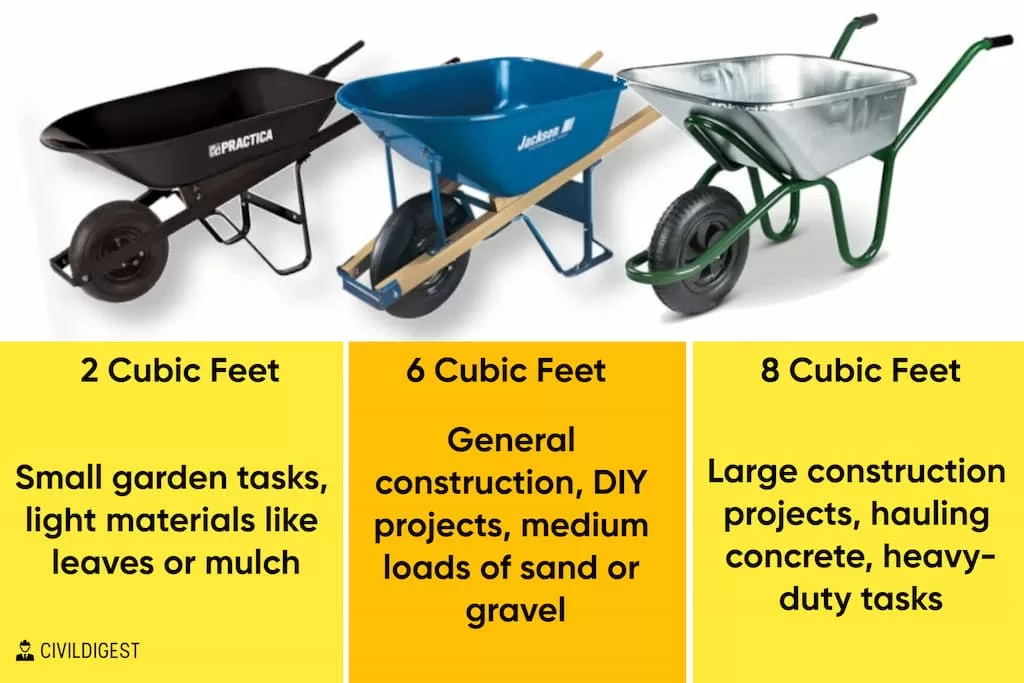Approximately 4 – 6 standard wheelbarrows make up a yard of concrete. Welcome to our comprehensive guide on “How Many Wheelbarrows in a Yard of Concrete.” This article is designed to simplify complex calculations and give you the insights you need for your construction projects. From exploring the intricacies of cubic yards and wheelbarrow sizes to offering a specialized wheelbarrow calculator tool, we’ve got you covered. Make your construction planning seamless and efficient with our in-depth guide.
Table of Contents
What is a Cubic Yard
A cubic yard is a unit that measures volume, defined as the space occupied by a cube that is 1 yard (3 feet or 36 inches) on each side. Simple math shows that one cubic yard equals 27 cubic feet (3 x 3 x 3). It’s the go-to metric in the U.S. for large quantities of construction materials.
How to Calculate Cubic Yards
- Measure Length, Width, and Height: Use a tape measure to find these dimensions in feet.
- Multiply the Dimensions: Multiply the length, width, and height together.
- For example: If an area is 3 feet long, 3 feet wide, and 3 feet high, then: 3 x 3 x 3 = 27 cubic feet.
- Convert to Cubic Yards: Divide by 27 to convert cubic feet to cubic yards.
- For example: 27 cubic feet ÷ 27 = 1 cubic yard
How Does it Relate to a Wheelbarrow?
A standard construction wheelbarrow typically holds about 6 cubic feet of material. Knowing the cubic yardage of a material helps you calculate how many wheelbarrow loads you’ll need for a job. We’ll explore this in detail in later sections.
Wheelbarrow Sizes and Types
Navigating through the maze of wheelbarrow sizes and types is essential for construction project management. Your choice can directly influence labor costs, efficiency, and the overall success of your work. As someone who’s managed various construction sites, I can assure you that making the right choice can save time, money, and labor.

Wheelbarrow Sizes
Wheelbarrows come in a variety of sizes, designed to suit specific tasks and materials. Here are the sizes you’ll most often encounter:
| Wheelbarrow Size | Volume in Cubic Feet | Best Suited For |
| Small | 2-3 Cubic Feet | For small garden tasks, light materials like leaves or mulch |
| Medium | 4-6 Cubic Feet | General construction, DIY projects, medium loads of sand or gravel |
| Large | 7-10 Cubic Feet | Large construction projects, hauling concrete, heavy-duty tasks |
How To Measure One Wheelbarrow’s Volume Capacity
Calculating the volume capacity of a wheelbarrow is straightforward but crucial. The process helps you determine how much material you can haul at once. Let me guide you through it, based on my own field experience.
Steps to Measure Wheelbarrow Volume:
- Length: Measure the internal length of the wheelbarrow from front to back.
- Width: Measure the internal width of the wheelbarrow from one side to the other.
- Depth: Measure the internal depth of the wheelbarrow.
Volume Calculation:
- Formula: The volume (V) is calculated using the formula V=Length×Width×Depth.
- Units: Ensure all measurements are in the same unit (e.g., feet) for accurate calculations.
Example: If your wheelbarrow measures 2 feet in length, 1.5 feet in width, and 1 foot in depth, then:
Volume = 2 ft (Length) × 1.5 ft (Width) × 1 ft (Depth) = 3 cubic feet
Standard Wheelbarrows

Standard wheelbarrows are often the go-to choice for many DIY and minor construction projects. Here’s what you need to know:
- Capacity: Typically between 4-6 cubic feet
- Material: Usually made from plastic or steel
- Wheels: Single wheel for maneuverability
I’ve used standard wheelbarrows in various settings, from residential construction to minor landscaping projects. Their versatility and ease of use make them an excellent choice for most general tasks.
Contractor Wheelbarrows

For heavy-duty jobs, contractor wheelbarrows are your best bet. Here are their defining features:
- Capacity: Ranges between 6-10 cubic feet
- Material: Generally made of heavy-duty steel
- Wheels: Often come with dual wheels for added stability and strength
Having managed large-scale construction projects, I can attest to the necessity of contractor wheelbarrows for heavy loads, especially when it comes to materials like concrete or large quantities of gravel.
Both standard and contractor wheelbarrows have their places in construction. The key is to match the wheelbarrow type and size to the job at hand. Trust me, having the right tool can make all the difference in meeting your project deadlines and staying within budget.
How Many Wheelbarrows Full of Concrete for 1 Yard?
First, let’s clarify: 1 cubic yard of concrete is equal to 27 cubic feet.
Calculation Steps:
Here’s how you can figure out the number of wheelbarrows you’d need for 1 yard of concrete.
- Identify Wheelbarrow Size: Let’s say you have a standard wheelbarrow with a volume of 6 cubic feet.
- Divide Total Volume by Wheelbarrow Size: Divide 27 cubic feet by the wheelbarrow’s volume.
If your wheelbarrow has a 6 cubic foot capacity, you’d need:
Number of Wheelbarrows = 27 Cubic Feet (1 yard) / 6 Cubic Feet (wheelbarrow size) = 4.5 wheelbarrows
How many wheelbarrows in 1 meter of concrete?
One cubic meter of concrete equals approximately 1.31 cubic yards.
- Identify Wheelbarrow Size: For this example, let’s assume you have a wheelbarrow that holds 0.17 cubic meters (which is roughly equivalent to 6 cubic feet).
- Divide Total Volume by Wheelbarrow Size: Divide 1 cubic meter by the wheelbarrow’s volume.
If your wheelbarrow has a 0.17 cubic meter capacity, you’d need:
Number of Wheelbarrows = 1 Cubic Meter / 0.17 Cubic Meters (wheelbarrow size) = 5.88 wheelbarrows
In my experience, accurate material estimation is key to meeting project deadlines and budget constraints.
The Weight and Volume of Wheelbarrows with Materials
Working on a construction site means constantly transporting materials. Knowing how much a wheelbarrow can hold in terms of weight can save you time and manpower. In my years as a civil engineer, I’ve found that understanding these metrics can greatly optimize workflow.
How Heavy is a Wheelbarrow Full of Concrete?
For a Standard Wheelbarrow with a 6 cubic foot capacity, the weight of concrete it can hold is approximately 900 lbs. In the case of a Contractor Wheelbarrow with an 8 cubic foot capacity, it can hold up to 1,200 lbs of concrete.

Concrete generally has a density of about 150 lbs per cubic foot. Here’s how the weight varies between a standard and a contractor wheelbarrow:
Standard Wheelbarrow (6 Cubic Feet)
Weight of concrete = Volume of wheelbarrow x Density of concrete
Weight = 6 cubic feet x 150 lbs/cubic foot
Weight = 900 lbs
Contractor Wheelbarrow (8 Cubic Feet)
Weight of concrete = Volume of wheelbarrow x Density of concrete
Weight = 8 cubic feet x 150 lbs/cubic foot
Weight = 1,200 lbs
How Much Does a Cubic Yard of Gravel Weigh?
A cubic yard of gravel can weigh anywhere from 2,400 to 2,700 lbs, depending on its type and density.

Example:
1 Cubic Yard of River Rock Gravel = 2,400 lbs
1 Cubic Yard of Crushed Stone Gravel = 2,700 lbs
How Much Does a Yard of Sand Weigh?
A cubic yard of dry sand weighs around 2,700 lbs, while wet sand can weigh up to 3,000 lbs.
Example:
1 Cubic Yard of Dry Sand = 2,700 lbs
1 Cubic Yard of Wet Sand = 3,000 lbs
Wheelbarrow Calculator
Calculating the number of wheelbarrow loads required for your construction project just got easier! Below is a simple yet effective calculator tool that can save you time and prevent costly errors.
How to Use the Wheelbarrow Calculator:
- Input Volume of Material in Cubic Yards: Whether it’s concrete, sand, or gravel, enter the total volume you’ll need for your project.
- Select Wheelbarrow Type: Choose between a standard wheelbarrow (6 cubic feet) or a contractor wheelbarrow (8 cubic feet).
Online Wheelbarrow Calculator Tool
Why This Tool?
Accuracy: This tool minimizes human error, offering a more accurate count of the number of wheelbarrow loads required.
Convenience: With just a couple of clicks, you can get your results instantaneously.
Cost-Efficiency: Precise calculations help you order the correct amount of material, saving you from wastage and excess costs.
This wheelbarrow calculator tool is a practical addition to any construction project, streamlining the planning process and ensuring that you have just the right amount of material needed.
Related tool: Crushed Concrete Calculator
Conclusion
We delved into the different sizes of wheelbarrows, and the volume and weight of various construction materials, and even offered a handy wheelbarrow calculator tool for quick calculations. Equipped with this knowledge, you can approach your next construction project with greater confidence and precision. Whether you’re a seasoned contractor or a DIY enthusiast, the insights provided here serve as a robust framework for effective planning and execution of your construction endeavors.












